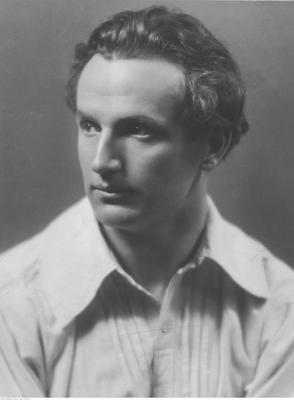Jan Ciepliński was born May 10, 1900 in Warsaw, died April 17 or 21, 1972 in New York.
Jan Ciepliński was a dancer, choreographer, pedagogue and ballet historian. Between 1909 and 1918, he was a student at the Warsaw Ballet School. He made his debut on the stage of the Grand Theater in Warsaw as early as 1915, and from 1918 to 1821 he performed as a soloist there, including in Giselle and Pan Twardowski. In 1919, when the Polish Actors Association (ZASP) was founded, he took on the task of organizing a ballet section at the Grand Theater and became its head. Very early on, he revealed his choreographic abilities, which resulted in the development of the Artistic Dance Night, presented at the Warsaw Philharmonic Hall on April 14, 1921. In 1921, he joined Anna Pavlova’s ballet, touring Europe and the USA for a year. In 1922, he returned to Warsaw and organized his own company of nearly thirty members, the Jan Ciepliński Ballet, with whom he performed for three seasons on the opera stages of Katowice, Poznań and Vilnius as dancer, choreographer and ballet director. The company mainly performed the repertoire based on national tradition, including: S. Moniuszko’s Halka and Fairy Tale; Lithuanian Rhapsody, The Wedding in Ojców, (in which he danced as the Bridegroom). He also produced Carnaval and The Afternoon of a Faun, as well as Italian Caprice, The Fairy Doll and numerous miniatures based on Polish national dances. In 1924 the Ciepliński Ballet performed in Vienna, showcasing a compilation of Polish dances. In its last season, the company gave regular performances at the Grand Theater in Vilnius. In 1925, Ciepliński was engaged by Sergei Diaghilev’s Ballets Russes, in which he danced small solo parts until 1927, including in Les Matelots, La Boutique fantasque, The Triumph of Neptune. From 1927 to 1931 he was associated as ballet master and choreographer with the Royal Opera House in Stockholm, where his productions included The Nutcracker, Coppelia, The Fairy Doll, as well as ballets to music by Swedish composers. From 1930 to 1934, he was ballet director and choreographer of the Royal Opera House in Budapest, where, as in Stockholm, he staged classical repertoire, complemented by native musical traditions.
In the 1934/35 season, he became chief ballet master and choreographer of the Grand Theater in Warsaw and head of the ballet school there. He reorganized and revived the ballet company, engaging many young dancers and once again producing Coppelia, in which he starred as Coppelius. His career in the Warsaw ballet was interrupted by an incident involving the slapping of Serge Lifar, who published a slanting review in the press concerning the quality of the Grand Theater’s ballet company. In June 1935, Ciepliński left for Buenos Aires and took a job as a choreographer at the Teatro Colón. At the same time, he continued his choreographic cooperation with the Budapest stage. After returning to Poland in 1937, he proceeded to organize his own company for the second time, which was called the Warsaw Ballet and aimed to promote Polish national dances. The company’s members included: Halina Szmolcówna, Zygmunt Dąbrowski, Jadwiga Hryniewiecka and Ziuta Buczyńska. The Warsaw Ballet performed in Poland and in Budapest, Prague and Vilnius. In 1938, Ciepliński signed a commitment to the Polish Representative Ballet and was its ballet master and choreographer until 1939 (Harnasie, Fairy Tales to the music of Stanisław Moniuszko, The Knight of the Silver Rose to the music of Richard Strauss). At the same time, as a dance teacher, he worked with Helena Hryniewiecki’s drama school. He starred in the film The Ghosts, directed by Eugeniusz Cękalski and Karol Szołowski.
During the German occupation of Poland, from 1940 to 1943, he served as the ballet master and choreographer of the official Theater of the City of Warsaw (Theater der Stadt Warschau), for which he was sentenced to infamy by a verdict of the Directorate of Underground Resistance. In 1943, he left Poland for Budapest, where he was a choreographer at the local Opera House until 1948. In 1948, he moved to London, where he worked with the Anglo-Polish Ballet, Mercury Theatre, among others, and taught at various ballet studios. Between 1951 and 1954, he was choreographer of The Ballet Legat; he staged The Wedding in Ojców and Coppelia (in which he danced as Coppelius). He taught Polish dances in London’s Polish community troupes, and was also a choreographer at the Polish Centre in London. He worked actively in the Artistic Committee of the Polish Actors Association Abroad (ZASP za Granicą). In 1959, he moved to New York, where he spent the final twenty three years of his life, engaging in the work of the Polonia Opera Co. He also led the Polish diaspora’s dance companies, as well as reading activities. He wrote articles for the English, American and Polish-American press. In 1956, he published Szkic dziejów baletu polskiego in London. 1983 saw the publication of the English-language version of his book, titled A History of Polish Ballet 1518-1945.
